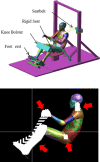Analysis of individual differences in pelvic and spine alignment in seated posture and impact on the seatbelt kinematics using human body model
- PMID: 34242288
- PMCID: PMC8270461
- DOI: 10.1371/journal.pone.0254120
Analysis of individual differences in pelvic and spine alignment in seated posture and impact on the seatbelt kinematics using human body model
Abstract
Analysis using human body models has been performed to reduce the impact of accidents; however, no analysis has shown a relationship between lumbar and pelvic/spine angle and seat belts in reducing human damage from accidents. Lumbar and pelvic/spine angles were measured in 75 individuals and the measurements were used to create three different angles for the Total Human Model for Safety model. In the present study, we focused on lumber lordosis (LL) and pelvic angle (PA). A normal distribution and histogram were used for analysis of PA (01, 10, and 50). The Total Human Model for Safety, including LL and PA, was corrected using finite element software. Simulations were conducted under the conditions of the Japan New Car Assessment Programme (JNCAP) 56 kph full lap frontal impact. Using the results of the FEM, the amount of lap-belt cranial sliding-up, anterior movement of the pelvis, posterior tilt of the pelvis, head injury criterion (HIC), second cervical vertebrae (C2) compressive load, C2 moment, chest deflectiou (upper, middle, and lower), left and right femur load, and shoulder belt force were measured. The lap-belt cranial sliding-up was 1.91 and 2.37 for PA10 and PA01, respectively, compared to PA50; the anterior movement of the pelvis was 1.08 and 1.12 for PA10 and PA01, respectively; and the posterior tilt of the pelvis was 1.1 and 1.18 for PA10 and PA01, respectively. HIC was 1.13 for PA10 and 1.58 for PA01; there was no difference in C2 compressive load by PA, but C2 moment increased to 1.59 for PA10 and 2.72 for PA01. It was found that as LL increases and the PA decreases, the seat belt becomes likely to catch the iliac bone, making it harder to cause injury. This study could help to reconsider the safe seat and seatbelt position in the future.
Conflict of interest statement
Mazda Motor Corporation provided $30,000 to cover joint 2017 research expenses for this study. This does not alter our adherence to PLOS ONE policies on sharing data and materials.
Figures






References
-
- Dell’Erba A, Di Vella G, Giardino N. Seatbelt injury to the common iliac artery: case report. J Forensic Sci. 1998;43(1):215–7. - PubMed
MeSH terms
LinkOut - more resources
Full Text Sources
Research Materials
Miscellaneous

